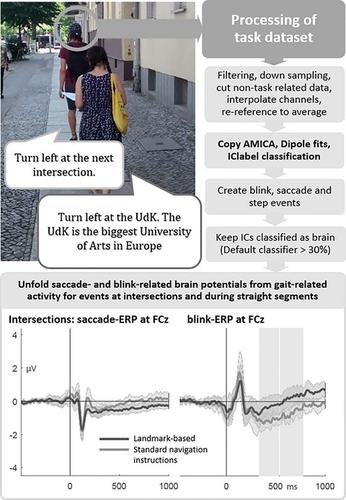当前位置:
X-MOL 学术
›
Eur. J. Nerosci.
›
论文详情
Our official English website, www.x-mol.net, welcomes your feedback! (Note: you will need to create a separate account there.)
Eye movement-related brain potentials during assisted navigation in real-world environments
European Journal of Neroscience ( IF 3.4 ) Pub Date : 2020-12-28 , DOI: 10.1111/ejn.15095 Anna Wunderlich 1 , Klaus Gramann 1, 2, 3
European Journal of Neroscience ( IF 3.4 ) Pub Date : 2020-12-28 , DOI: 10.1111/ejn.15095 Anna Wunderlich 1 , Klaus Gramann 1, 2, 3
Affiliation

|
Conducting neuroscience research in the real-world remains challenging because of movement- and environment-related artifacts as well as missing control over stimulus presentation. The present study overcame these restrictions by mobile electroencephalography (EEG) and data-driven analysis approaches during a real-world navigation task. During assisted navigation through an unfamiliar city environment, participants received either standard or landmark-based auditory navigation instructions. EEG data were recorded continuously during navigation. Saccade- and blink-events as well as gait-related EEG activity were extracted from sensor level data. Brain activity associated with the navigation task was identified by subsequent source-based cleaning of non-brain activity and unfolding of overlapping event-related potentials. When navigators received landmark-based instructions compared to those receiving standard navigation instructions, the blink-related brain potentials during navigation revealed higher amplitudes at fronto-central leads in a time window starting at 300 ms after blinks, which was accompanied by improved spatial knowledge acquisition tested in follow-up spatial tasks. Replicating improved spatial knowledge acquisition from previous experiments, the present study revealed eye movement-related brain potentials to point to the involvement of higher cognitive processes and increased processing of incoming information during periods of landmark-based instructions. The study revealed neuronal correlates underlying visuospatial information processing during assisted navigation in the real-world providing a new analysis approach for neuroscientific research in freely moving participants in uncontrollable real-world environments.
中文翻译:

现实环境中辅助导航期间与眼球运动相关的脑电位
由于与运动和环境相关的伪影以及对刺激呈现的缺乏控制,在现实世界中进行神经科学研究仍然具有挑战性。本研究在现实世界的导航任务中通过移动脑电图 (EEG) 和数据驱动的分析方法克服了这些限制。在通过陌生城市环境进行辅助导航期间,参与者收到标准或基于地标的听觉导航指令。在导航期间连续记录脑电图数据。从传感器水平数据中提取了扫视和眨眼事件以及与步态相关的脑电图活动。与导航任务相关的大脑活动通过随后基于源的非大脑活动清理和重叠事件相关电位的展开来识别。与接收标准导航指令的导航员相比,当导航员接收到基于地标的指令时,导航期间与眨眼相关的脑电位显示,在眨眼后 300 毫秒开始的时间窗口内,额中央导联处的幅度更高,这伴随着空间知识获取的改善在后续空间任务中进行测试。从先前的实验中复制改进的空间知识获取,本研究揭示了与眼球运动相关的大脑潜力,表明在基于地标的指令期间,更高的认知过程和传入信息的处理增加。
更新日期:2020-12-28
中文翻译:

现实环境中辅助导航期间与眼球运动相关的脑电位
由于与运动和环境相关的伪影以及对刺激呈现的缺乏控制,在现实世界中进行神经科学研究仍然具有挑战性。本研究在现实世界的导航任务中通过移动脑电图 (EEG) 和数据驱动的分析方法克服了这些限制。在通过陌生城市环境进行辅助导航期间,参与者收到标准或基于地标的听觉导航指令。在导航期间连续记录脑电图数据。从传感器水平数据中提取了扫视和眨眼事件以及与步态相关的脑电图活动。与导航任务相关的大脑活动通过随后基于源的非大脑活动清理和重叠事件相关电位的展开来识别。与接收标准导航指令的导航员相比,当导航员接收到基于地标的指令时,导航期间与眨眼相关的脑电位显示,在眨眼后 300 毫秒开始的时间窗口内,额中央导联处的幅度更高,这伴随着空间知识获取的改善在后续空间任务中进行测试。从先前的实验中复制改进的空间知识获取,本研究揭示了与眼球运动相关的大脑潜力,表明在基于地标的指令期间,更高的认知过程和传入信息的处理增加。


























 京公网安备 11010802027423号
京公网安备 11010802027423号